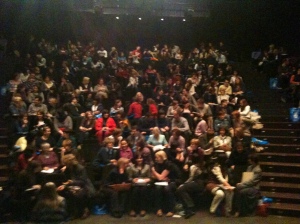How do you plan a successful presentation? June 10, 2010 Jeremy Harmer
I was chatting on the phone to one of my friends the other day. She is the deputy head at a large primary school here in the UK. She was telling me that she had to give a presentation to 300 or so primary teachers and heads in which her task was to explain her school’s approach to the curriculum. And so we got to talking, as you do, about how to plan a presentation, and how to make information transfer (which is what a lot of presenting really entails) engaging and thought-provoking. Inspiring even – and the work she does should inspire people, it really should!
And just for good measure we talked about the pitfalls of using powerpoint.
The question that was preoccupying her – and which always preoccupies me when I start to plan a new session – is how to build a narrative through the presentation. What’s the best way of starting a talk or a workshop? How can images and audio/video be made to contribute to the whole thing? How should you end the session? In short, how do you plan a successful talk?
I think there may be (there MAY be, I am not sure) a difference between planning a good lesson and planning a good talk. But just supposing there isn’t? Scott Thornbury talked about planning metaphors in an article some time ago – teachers often think of good lessons as plays, novels, pieces of music etc. That certainly helps. But how do pieces of music start? Or novels? Or plays? How do they finish? How should talks, lessons, even conferences end? I Have done a big talk on that last point (one which I am thrilled to be repeating at BRAZTESOLin a few weeks)
I once went to a workshop on how to be a good presenter given by Mario Rinvolucri. He suggested you should always start by asking the audience to do something (dictate a sentence, for example, which they have to complete and then share with their partners). That takes the pressure off the speaker and makes the audience feel as if they are engaged. Another way is to start by posing a big question – a problem, a dilemma etc – and build a talk on that. You can also start by throwing up an image or recounting an experience which is so arresting (in the sense of attracting attention), that the audience is hooked straight away. You can start by launching straight into a compelling story, and then build a talk on that.
But however you start, you have to find a way through all the information that you want to share – or have your participants discuss or interact with. Where’s the path through the woods? Where is (to re-use a word I started with) the narrative?
I have to give a talk tomorrow at Christchurch University Canterbury in the south of England. I have decided to use some edited clips of little flipcam interviews (see my earlier post) which I have done with a range of teachers from the UK, Turkey, Pakistan, China, Grenada, Argentina and Romania. In these clips, the teachers describe a successful lesson they have taught. It usually takes them only about a minute or two (you can usually find one of them on the Pearson ELT Community website). I want to get the participants to reflect on teacher beliefs and teacher practice. At least that’s what I THINK I want to do.
I could, of course, just show the lots of videos and then just say ‘discuss’. But that doesn’t seem right. I need a story. I need categories, threads (to use Tessa Woodward’s term from her book on planning), hooks for the participants to be able to hang things on.
I think it was Raymond Chandler who gave advice to writers who got stuck when writing. Just have someone walk into the room with a gun was his advice, and then the story will kind of take over.
Hmm.
So my questions for you are things like:
- How do you start your talks?
- How do you end them?
- How do YOU go about planning them?
- What’s YOUR personal take on this?
Because, even after all this time, it doesn’t get any easier!
